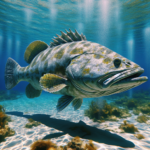Deep-Sea Fishing for Tuna in the Gulf of Mexico

Introduction
Did you know that the Gulf of Mexico is home to some of the most sought-after tuna species in the world? Deep-sea fishing for tuna in this region offers an exhilarating experience for both novice and seasoned anglers. This article will delve into the intricacies of deep-sea fishing for tuna in the Gulf of Mexico, covering everything from the best fishing techniques and gear to the top fishing spots and seasonal considerations.
Whether you’re looking to master a new fishing technique, find the best fishing spots, or prepare for an upcoming fishing event, this comprehensive guide will provide you with all the information you need to make your deep-sea fishing adventure a success.
Background/Context
Historical or Cultural Significance
The Gulf of Mexico has a rich history of fishing that dates back centuries. Indigenous peoples and early settlers relied on the abundant marine life for sustenance. Over time, the Gulf has become a hotspot for commercial and recreational fishing, particularly for species like tuna. The cultural significance of fishing in this region is deeply rooted, with many local communities depending on it for their livelihoods.
Geographical Overview
The Gulf of Mexico is a large ocean basin bordered by the United States, Mexico, and Cuba. It features a diverse ecosystem with a variety of marine habitats, including coral reefs, seagrass beds, and deep-sea environments. The climate is generally warm, with water temperatures ranging from 70°F to 90°F, making it an ideal habitat for tuna and other pelagic species.
Key Points/Details
Fishing Techniques
Technique Overview
Deep-sea fishing for tuna typically involves trolling, chunking, and jigging. Trolling involves dragging lures or baited hooks behind a moving boat, while chunking uses pieces of bait to attract tuna to the boat. Jigging involves using a weighted lure that is jerked up and down to mimic the movement of prey.
When and Where to Use
Trolling is most effective in open waters where tuna are actively hunting. Chunking is best used when you have located a school of tuna, as it helps to keep them near the boat. Jigging is effective in deeper waters where tuna are feeding near the bottom.
Recommended Gear
- Rods: Heavy-duty trolling rods or jigging rods.
- Reels: High-capacity spinning or conventional reels with strong drag systems.
- Lines: Braided lines with a high breaking strength (50-100 lb test).
- Bait/Lures: Live bait (such as mackerel or squid), artificial lures, and jigs.
Species Information
Species Overview
The Gulf of Mexico is home to several tuna species, including Yellowfin Tuna, Blackfin Tuna, and Bluefin Tuna. Yellowfin Tuna are known for their speed and strength, making them a popular target for sport fishing. Blackfin Tuna are smaller but abundant, while Bluefin Tuna are the largest and most prized, though they are less common.
Best Practices
To successfully catch tuna, it’s essential to use the right techniques and gear. Trolling with live bait or lures is effective for Yellowfin and Bluefin Tuna, while chunking works well for Blackfin Tuna. It’s also important to fish during the right season and time of day, as tuna are more active during certain periods.
Location Information
Top Fishing Spots
- Venice, Louisiana: Known as the “Tuna Capital of the World,” Venice offers excellent opportunities for catching Yellowfin Tuna.
- Destin, Florida: This area is famous for its deep-sea fishing charters and abundant Blackfin Tuna.
- Port Aransas, Texas: A popular spot for Bluefin Tuna, especially during the winter months.
Regulations and Licenses
Fishing regulations in the Gulf of Mexico vary by state and species. Anglers must obtain a fishing license and adhere to catch limits and seasonal restrictions. It’s crucial to check local regulations before heading out to ensure compliance.
Seasonal Considerations
Seasonal Variations
Fishing conditions in the Gulf of Mexico change throughout the year. Tuna are more abundant during certain seasons, with Yellowfin Tuna being most active in the summer and fall, Blackfin Tuna in the spring and fall, and Bluefin Tuna in the winter.
Best Times to Fish
The optimal times for tuna fishing are early morning and late afternoon when the fish are most active. Night fishing can also be productive, especially for Yellowfin Tuna.
Events and Tournaments
Event Overview
The Gulf of Mexico hosts several fishing tournaments throughout the year, including the Louisiana Gulf Coast Billfish Classic and the Destin Fishing Rodeo. These events attract anglers from around the world and offer substantial prizes.
Preparation Tips
To prepare for a fishing tournament, ensure your gear is in top condition, practice your techniques, and familiarize yourself with the tournament rules. It’s also helpful to scout the fishing area in advance to identify potential hotspots.
Tips and Best Practices
General Tips
- Always check the weather forecast before heading out.
- Use fresh bait to increase your chances of attracting tuna.
- Keep your gear well-maintained to avoid equipment failure.
Avoid Common Mistakes
- Not using the right gear for the target species.
- Ignoring local fishing regulations and catch limits.
- Fishing at the wrong time of day or season.
Advanced Techniques
- Using sonar and fish finders to locate schools of tuna.
- Employing kite fishing to present bait on the water’s surface.
- Mastering the art of live bait rigging for more natural presentations.
Gear and Equipment Recommendations
Essential Gear
- Heavy-duty trolling rods and reels.
- Braided fishing lines with high breaking strength.
- Live bait and artificial lures.
- Fish finders and sonar equipment.
Optional Gear/Upgrades
- Kite fishing rigs.
- High-quality gaffs and nets for landing fish.
- Advanced GPS and navigation systems.
Where to Buy or Rent
Local tackle shops in coastal towns like Venice, Destin, and Port Aransas offer a wide range of fishing gear. Online retailers like Bass Pro Shops and Cabela’s also provide extensive selections. Some charter services offer gear rentals as part of their packages.
Safety and Conservation
Safety Tips
- Always wear a life jacket when on the water.
- Be aware of weather conditions and avoid fishing during storms.
- Stay hydrated and protect yourself from the sun.
Conservation Practices
- Practice catch and release to help sustain tuna populations.
- Respect local wildlife and avoid disturbing marine habitats.
- Follow all fishing regulations and catch limits.
Planning Your Trip
Accommodations
There are numerous lodging options near popular fishing spots in the Gulf of Mexico. Venice, Louisiana, offers fishing lodges and hotels, while Destin, Florida, has a range of beachfront resorts and vacation rentals. Port Aransas, Texas, also provides various accommodations, from budget motels to luxury condos.
Travel Tips
When planning your trip, consider the best routes to your destination and any transportation needs. Many coastal towns have airports nearby, making air travel a convenient option. Renting a car can provide flexibility for exploring different fishing spots.
Additional Activities
In addition to fishing, the Gulf of Mexico offers various activities for non-fishing time. Enjoy water sports like snorkeling and scuba diving, explore local beaches, or visit nearby attractions such as wildlife reserves and historical sites.
Frequently Asked Questions (FAQs)
What is the best time of year to fish for tuna in the Gulf of Mexico?
The best time to fish for Yellowfin Tuna is during the summer and fall, Blackfin Tuna in the spring and fall, and Bluefin Tuna in the winter.
Do I need a fishing license to fish in the Gulf of Mexico?
Yes, a fishing license is required, and anglers must adhere to local regulations and catch limits.
What gear do I need for deep-sea tuna fishing?
Essential gear includes heavy-duty trolling rods and reels, braided fishing lines, live bait, artificial lures, and fish finders.
Are there any fishing tournaments in the Gulf of Mexico?
Yes, the Gulf of Mexico hosts several fishing tournaments, including the Louisiana Gulf Coast Billfish Classic and the Destin Fishing Rodeo.
Conclusion
Deep-sea fishing for tuna in the Gulf of Mexico offers an exciting and rewarding experience for anglers of all skill levels. By understanding the best fishing techniques, gear, and locations, you can increase your chances of a successful trip. Remember to follow local regulations, practice conservation, and prioritize safety to ensure a sustainable and enjoyable fishing adventure. So gear up, plan your trip, and get ready to reel in some of the most prized tuna in the world!




